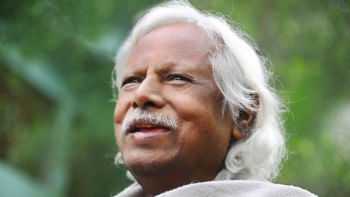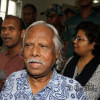Zafrullah: Tribute to a freedom fighter and revolutionary

With Dr Zafrullah Chowdhury's passing, we have interred one of the few genuine social revolutionaries visible in Bangladesh's public domain. Zafrullah was indeed a frontline freedom fighter and was universally recognised as such. He did not participate in the war remotely, through campaigning abroad for our liberation, as many of us did. Such campaigns did valuable service to the course of the war, but is not comparable to travelling from London to Agartala, setting up a field hospital from scratch, on the front line of the war zone, and working round the clock to tend to the wounded and sick. He and his colleagues thereby saved lives and, in many cases, enabled the injured to return to the battlefield.
I do not know of too many people who actually gave up their lifestyles abroad to immediately join the Liberation War. Quite a number, such as Fazle Hasan Abed and Muhammad Yunus, did return to Bangladesh from abroad immediately after liberation and committed themselves to a life of service to the dukhi manush, as did Zafrullah and many others. For this class of young men and women, the Liberation War had a life-changing impact and inspired them to give up more conventional lives committed to professional advancement commensurate with their education and class. Yunus and Abed moved away from their projected career paths to build world-famous organisations, which served to improve the lives of millions of people not just in Bangladesh, but around the world. Other such social entrepreneurs have played an important role in writing Bangladesh's globally recognised success story of reducing poverty and promoting the human development of its people.
Zafrullah always remained anchored in Bangladesh. His point of departure lay in the revolutionary nature of his consciousness and actions. This was manifested in his decision to abandon his quest for a possible FRCS, the dream of every aspirant Bangalee medical practitioner, just a few weeks before his final exam – his decision to abandon his Pakistani nationality and to publicly tear up his passport, and his decision to join the Liberation War as a soldier. When he reached Kolkata, he did not linger there and join his many compatriots taking refuge there, but immediately moved to Tripura on the front line of the battlefield and decided to set up a field hospital. Presumably, studying for an FRCS does not educate anyone about how to set up a battlefield hospital with limited resources at hand or few experienced personnel available to him. Such a bold, risk-prone involvement, for a young man, required a revolutionary consciousness where you decide to do things that no one has thought of, and to do so for the first time.
Zafrullah's move to set up Gonoshasthaya Kendra in Savar was itself based on a revolutionary conception. I suspect that Zafrullah was inspired by ideas drawn from the Chinese Revolution led by Mao, which in its early years sought to provide health for all, using limited resources, socially appropriate technology, and the use of so-called "barefoot doctors" – medical practitioners with limited education from the grass roots, who could be provided with basic training to take care of the most frequently recurring medical problems of ordinary people.
Zafrullah's further revolutionary act was to engage the working people of Savar in taking care of their own health problems by investing in low-cost preventative care. Such care was mostly provided by the revolutionary act of bringing young village girls out of the seclusion of their homes, training them to work as healthcare providers, and eventually drawing them into a variety of other non-traditional activities such as riding bicycles, driving cars, working with machinery, and serving as security guards. All such activities by women are more commonplace now. But in the 1970s, these were social revolutionary acts, more so than microfinance, which was built around helping women to generate income working from the seclusion of their homes. By the end of the 1970s, the Gonoshasthaya women were ubiquitous across the landscape of Savar, engaged in work that was once inconceivable for any woman.
To build a cadre of "barefoot" healthcare providers required a revolutionary approach to medical education. Zafrullah believed – and I remember him explaining this on various public platforms and to me personally – that the courses training medical students for the MBBS degree were inappropriate and not cost-effective for serving the health needs of the majority of the then low-income population, who mostly lived in the rural areas.
He argued that more elaborate training must indeed go on to meet the needs of patients with more complicated diseases and illnesses. But for the more commonplace illnesses suffered by a great majority of people such as fevers, low-grade infections, diarrhoeal diseases, simple injuries and the need for preventive care, a much shorter, more serviceable training programme would be cost-effective and could be completed in a much shorter time, which could produce large numbers of doctors/caregivers/nurses to meet the immediate needs of people. Moreover, such "graduates" would likely be more willing and able to live in the rural areas to service those most in need of affordable care. In contrast, five-year MBBS degrees produce a much smaller crop of caregivers whose graduates, in most cases, are less inclined to live and serve in the rural areas and spend their time and energy doing tadbir with the health ministry officials to be transferred to the metropolitan centres. It was Zafrullah's ideas on medical education which first attracted the wrath of the BMA and presumably many doctors with an MBBS. But he went on arguing about this to the end and eventually set up Gono University to give substance to his ideas.
Many people talk or argue for revolution. A smaller number are members of political parties that proclaim social revolution as part of their ideologies. For all of this class, their revolution remains largely aspirational since they have had little or no opportunity to demonstrate what a social revolution would amount to in practice. Zafrullah, who always proclaimed himself to be a socialist, believed that incremental change was not enough and that the social order itself needed to be changed. He could never do this on his own since such a move demanded political engagement and the emergence of necessary objective conditions. Instead, he attempted through his programmes at Gonoshasthaya Kendra to demonstrate what a "socialist" health system – relevant to the needs of the masses – might look like. He explored in real life what empowerment of the deprived through a social and gender revolution may demand.
His views on the pharmaceutical industry were also radical for its time. I remember around the early 1980s Zafrullah educating me to the fact that the MNCs who then monopolised the pharmaceutical industry marketed brand name medications at high prices, where their generics could be produced locally at lower costs. When he finally persuaded Gen Ershad to set new ground rules for banning branded medicines where generic alternatives were available, this was criticised and resisted by much of the pharmaceutical industry in Bangladesh, but particularly by the MNCs. Fortunately, the then government held firm and a large number of much favoured brand-name drugs, in popular use, were banned. The ban eventually led to an exodus from Bangladesh of most of the MNCs such as Pfizer, ICI, and Glaxo.
The good news was that, as predicted by Zafrullah, when he argued his case with Ershad for the drug policy reforms, the ban provided a great stimulus to the development of local pharmaceutical companies such as Square and Beximco. These ventures were given a quantum boost in their business fortunes when the MNCs vacated the local market for pharmaceutical products, leaving the field open for local companies. The further bonus came when the departing MNCs sold, on favourable terms, their production facilities, goodwill and, most important, their technological and managerial expertise, to their Bangladeshi CEOs and managers who thereby locally incorporated companies such as Renata, Eskayef, and ACI, now at the vanguard of Bangladesh's thriving pharma industry that today meets 90 percent of our needs for medication and is one of our most promising export industries.
The drug policy and its outcome provide an excellent example of the positive outcome of economic nationalism. Zafrullah's revolutionary consciousness was demonstrated by his vision and courage to take on one of the biggest sources of FDI in Bangladesh at the time, and to persuade a regime not known for its strong commitment to nationalism to stay the course in the face of much pressure from the Western countries, from where the MNCs originated.
At the end of the day, Zafrullah's revolutionary vision had, at best, a limited impact. Its social reach did not go much beyond Savar, and its achievements at the national level remain limited to the drug policy. His ideas on reforming medical education did not go far due to the resolute resistance of the BMA against his non-traditional ideas. His initiative to use Bangladeshi scientific expertise to develop a low-cost rapid testing kit for Covid infections was rejected by the health ministry, though such kits came to be widely produced abroad and are in regular use in Bangladesh through imports.
In his later years, even when his health was failing, he engaged himself in a variety of causes where he believed the values that had informed the liberation struggle to be endangered. In a political climate where public reasoning is itself in retreat, his gestures remained largely rhetorical but projected his indomitable spirit and courage.
Many people talk or argue for revolution. A smaller number are members of political parties that proclaim social revolution as part of their ideologies. For all of this class, their revolution remains largely aspirational since they have had little or no opportunity to demonstrate what a social revolution would amount to in practice. Zafrullah, who always proclaimed himself to be a socialist, believed that incremental change was not enough and that the social order itself needed to be changed. He could never do this on his own since such a move demanded political engagement and the emergence of necessary objective conditions. Instead, he attempted through his programmes at Gonoshasthaya Kendra to demonstrate what a "socialist" health system – relevant to the needs of the masses – might look like. He explored in real life what empowerment of the deprived through a social and gender revolution may demand. He was sufficiently successful in demonstrating his ideas on the ground in Savar, enough to occasionally arouse the wrath and resistance of local elites and fundamentalist forces.
In his own life, he lived simply, owned no property, and remained accessible to all people – particularly the dispossessed, to whom he was perceived not as a Neta, but as a Bhai.
May his life inspire those, particularly the young – who continue to believe in social revolution but are discouraged by the formidable obstacles that lie before them – to move along the path blazed by Zafrullah.
Prof Rehman Sobhan is chairman of the Centre for Policy Dialogue (CPD).

 For all latest news, follow The Daily Star's Google News channel.
For all latest news, follow The Daily Star's Google News channel. 











Comments